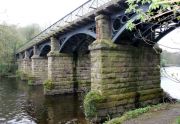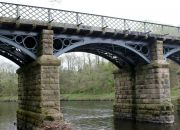Crook o'Lune Viaducts










The Crook O'Lune viaducts cross the River Lune at Caton, near Lancaster
There are two former railway bridges (west and east), recently restored for use by walkers and cyclists.
A car park and café are located close to the viaducts.
There is also a handsome masonry viaduct carrying Low Road over the River Lune.
The North Western Railway opened a line in 1849 from Lancaster to Wennington. Between Halton and Caton, the line had to cross a crook-shaped loop in the River Lune by two viaducts.
Wrought iron arches spring from sandstone-faced piers. There are six arches on the west viaduct and five on the east, supporting wooden decks.
An 1849 article on the opening of the railway refers to the viaducts having timber arches.[1]. These were replaced by wrought iron in the 1880s. See below.
1889 'Midland Railway Improvements. — We understand that preparations are in progress for the immediate doubling of the Midland RaUway Company's line from Hornby to Lancaster. This section of the popular route to Morecambe has, since it was first opened, remained a single line, and has been worked upon the staff system. Notwithstanding the most careful working, delays have, in consequence, been frequent and vexatious during the tourist and excursion season. Happily, so far as we remember, no accidents have ever occurred on the section. The distance from Hornby to Lancaster is nearly nine miles, and as, when the railway was first constructed, all the cuttings and bridges were made wide enough for two lines of rails, very little more will be required to be done beyond the ballasting and the laying of the permanent way. There is, however, one rather serious bit of work, but for which the doubling could be accomplished in a very short time. Between Caton and Halton, at the "Crook o'Lune," the railway twice crosses the river at points within a short distance of each other. About three years ago the original bridges, which were of timber, and were wide enough for two lines of rails, were removed and replaced by iron girders. Unfortunately the new bridges were only constructed for one line of rails, and they will now have to be widened. Some alterations will also be necessary at Halton and Caton Stations, and it is possible that at the latter place the old station will be replaced by a new one. It is hoped that the works may be so far advanced that the new line will be available by the time the pressure of summer traffic again comes round. — Bradford Observer..'[2]

